+1 (408)780-0908
Why is FITC used for Excitation and Emission in Flow Cytometry?
In flow cytometry, laser light is usually used to excite the fluorochromes. These lasers produce light in the UV and/or visible range. Fluorochromes are selected based on their abilities to fluoresce with the wavelengths of light produced by the lasers. The electrons of a fluorochrome can be excited by a range of wavelengths of light. This optimal wavelength is called the excitation peak. Similarly, the light produced by fluorochromes has a range of wavelengths and this optimal wavelength is called Emission Peak.
November 2, 2019
